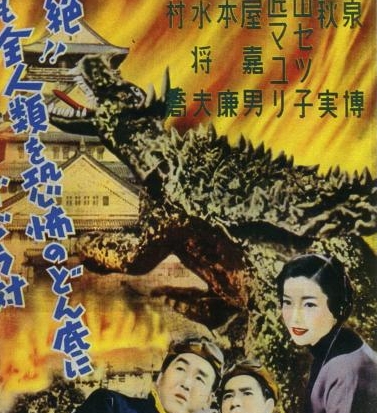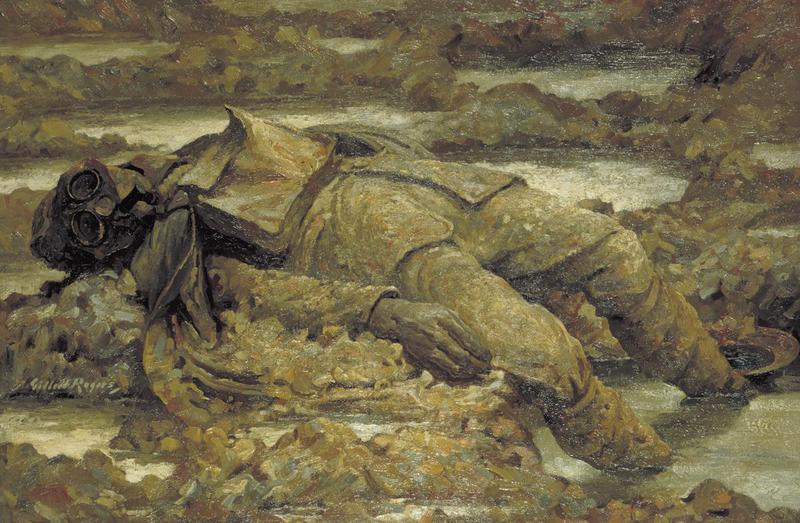by Sasha Kohan

Earlier this summer, Gareth Edwards’ take on the classic Godzilla broke records for the best opening weekend of any disaster movie and creature feature, raking in $93.2 million in the United States alone. One wonders, however, how many of those millions of American viewers were aware that this film would not exist were it not for a critical moment in our nation’s history.
It was, of course, the dropping of atomic bombs on Japan in August 1945 that served as the inspiration for the saurian creature that has become the mascot of Japanese pop culture and the inspiration for multitudinous movies, books, comics, television shows, and video games. With songs dedicated to him and statues built in his honor, Godzilla has even won an MTV Lifetime Achievement Award, one of only three fictional characters to do so.
In the sixty years since Godzilla’s conception, however, the meaning behind his story seems to have changed. Japan’s original 1954 Gojira is not what we see in Edwards’ most recent adaptation (although this may not be entirely bad – the CGI creature we see now has come a long way from the delightful campiness of the original monster-suit). How has Godzilla changed with time, and will he ever become irrelevant?
The allegorical journey of Godzilla began in spring 1954, when Tomoyuki Tanaka, producer for Toho Motion Picture Company, was challenged to make Japan’s first major monster movie and decided to work the film as a metaphor for the atomic bomb.
Japan is the only nation ever to have suffered a nuclear attack. Between 60,000 and 80,000 people were killed instantly upon Little Boy’s detonation over Hiroshima in 1945, with some bodies vanishing completely from the heat of the explosion and thousands of others dying from long-term effects of radiation exposure. The death toll would eventually reach 135,000. Three days later, more than 40,000 were killed instantly in Nagasaki, with total casualties reaching upwards of 50,000. It is not difficult to understand why so much of Japanese culture has revolved around the nuclear theme.
The idea for Godzilla, however, was not inspired by these incidents alone. The opening scene of Ishiro Honda’s original Gojira, in which a fishing boat is suddenly struck by a beam of bright light, is based on the March 1954 incident when the Japanese fishing boat Lucky Dragon 5 was exposed to severe radiation and nuclear fallout from the United States’ Castle Bravo device test on the Bikini Atoll. The explosion was more than twice as powerful as the bomb designers had expected and more than one thousand times as powerful as Little Boy. “Godzilla dramatizes nuclear horror unlike any other film of its period,” says film critic Steve Biodrowski, “because the fantasy element is clearly standing in for a reality too horrible to contemplate directly.” For audiences in America and around the world, Godzilla is and has always been a fantasy, an amusement, an entertainment; for the Japanese audiences of 1954, the film struck close to home.
In the 1956 American version of the film, significant alterations were made to Honda’s original. Along with the insertion of additional footage of actor Raymond Burr as an American reporter, these alterations included the cutting of several scenes that alluded to Godzilla’s connection with the bomb. Among the omitted sequences are references to the bomb being a threat to Japan and a realistic political debate over whether the public has the right to know the truth about Godzilla, or whether they should be protected from it. The most significant reference cut from the 1956 version, however, is much smaller and more poignant, occurring when two strangers aboard a train are making small talk about the latest Godzilla news. One woman laments the headlines and the idea of confronting another tragedy. “Not after I survived Nagasaki,” she says. Another man joins in with a reference to the firebombing of Tokyo, saying, “We have to evacuate again?” Even in this fictitious universe, Godzilla is not a just an allegorical stand-in for the bomb; he is a supplement to its reality. American film editors in 1956, however, were not comfortable in this universe. Moments of truth were omitted, and Godzilla’s American legacy grew as mere fantasy.
In the half-century following the creation of Godzilla, the Toho company produced 27 sequels to Honda’s original, and a sense of patriotism eventually became associated with the giant monster. “Godzilla,” writes professor of Japanese literature Susan J. Napier, “began as the ultimate alien who, as the series continued, became a friend to Japan, an insider, ‘one of us.’” While the 1954 original depicted a Japan in panic, Godzilla showed a traumatized audience just how much they had managed to overcome. The film’s view of science, nature, and humanity remained grim and pessimistic, but the creature became a mascot for a nation devastated by war and the following period of uplift and hopes for peace. According to Napier, “The series’ reassuring subtext remains the same throughout: even if famous monuments such as Tokyo Tower or the new Tokyo City Hall get trampled on, they can always be rebuilt.”
Considering the enormous significance of Godzilla in Japanese popular culture, Gareth Edwards’ recent hit remake is all the more curious and, perhaps, problematic. Even the notion of America adapting a film and legacy which was only created because of the thousands of lives lost and despair caused by Americans is uncomfortable, to say the least. Although Japan-U.S. relations are currently stable and civil, it seems somewhat problematic for the superpower that crushed another nation to ask to borrow a most beloved icon for our own enjoyment. However, Roland Emmerich had crossed this line already with his widely criticized 1998 version, hated among critics and Godzilla fans alike, and even rebranded and essentially disowned as “Zilla” by its parent-company, Toho. In licensing the film to Legendary Pictures, Toho set certain conditions under which the film was to be made, including that Godzilla was created from a nuclear incident, and that the film be set in Japan. While these conditions were basically met, it is certainly questionable whether Toho’s expectations were. Although Godzilla’s radioactive past is often referenced in the movie, it can hardly be said that this Godzilla really has anything to do with nuclear anxiety. While the basic structure of any Godzilla film is there, it is so loose and ambiguous that it simply becomes another monster movie: huge, uncontrollable creatures suddenly wreak havoc on densely populated city and destroy cultural (American) landmarks while cookie-cutter human melodrama happens in between battle scenes. Throw in some radiation, don’t forget to mention Japan, and BOOM – Godzilla movie, done.
Prior to its release, writer Frank Darabont was asked whether the new version would uphold the original nuclear allegory or “represent a different kind of metaphor, something we’re dealing with as a culture,” only for Darabont to respond saying that, in film, there is always “a margin of interpretation.” While this is already clear to the majority of movie-watchers, Edwards’ Godzilla seems to have rather a large margin.
In a somewhat contrived effort to remind audiences that they are well aware of Godzilla’s background, the 2014 filmmakers mention the events that started it all in a quick somber scene with the lone Japanese character of Dr. Ishiro Serizawa (Ken Watanabe). Dr. Serizawa shares with a confidant (and the audience) a remnant of his traumatic past: a watch that survived Hiroshima and belonged to his father. Unfortunately, the scene is so quick and out of the blue that it feels more like a forced moment of silence before the big games starts than a sincere acknowledgment of the past.
In fact, Watanabe’s entire character appears to have been created to preserve some remnant of the true spirit of Godzilla and the culture in which he was created. By simply being Japanese, mentioning Hiroshima, and uttering the tag line, “The arrogance of man is in thinking nature is in his control, and not the other way around,” Watanabe’s role is essentially objectified and confined. The tag line is misleading, however, or at least ambiguous, in that it may delude viewers into thinking it refers to the more topical, less edgy issue of global climate change.
What stands out most in Edwards’ Godzilla, however, is the distinct Americanness in which the original Japanese story has been soaked. The only scenes set in Godzilla’s homeland occur in the first half of the film, most of which, rather ironically, take place at a nuclear plant (not to mention the opening recreation of the very same hydrogen bomb test which led to the Lucky Dragon incident, perhaps included for fans of the 1954 original. This change of emphasis also begs the question of how appropriate it would be for even Japan to produce a Godzilla remake at this time. Beginning in the early 1970s, nuclear energy has been a national strategic priority of Japan and has come to provide a significant amount of the nation’s electricity. However, following the devastating tsunami in 2011, which killed nearly 20,000 people and triggered the disaster at Fukushima Daiichi nuclear power plant, Japanese public opinion on nuclear energy has largely reverted back to what it was following Godzilla’s original release, with polls finding up to 80 percent of the Japanese population were in favor of discontinuing the use of all fifty-four of the country’s nuclear reactors.
With this in mind, it seems as though the remake of a significantly anti-nuclear-powered allegory like Godzilla might have been met with slight confusion and discomfort – no more, however, than the U.S. version we were given leaves us with. Not only does the remake cloud Godzilla’s enormous significance in a potentially offensive “Americanness,” but it also does so in a way that so strangely seems to criticize itself that one could easily read the film as ultimately un-American. The main theme of this version, as embodied by Bryan Cranston’s character and his mission, is government distrust.
It is difficult to come away from this film without questioning the politics behind it. Ideas of democracy, unity, and peace are tainted by doubt and distrust. As we watch this American version of the Godzilla story, we are only reminded of our nation’s shortcomings, historic moments of horror and regret. While at times the film seems to be an attempt to charge American audiences with pride in their nation (not unsubtly done with the recurring image of Godzilla destroying Chinatown – representative of another world superpower with which we seem to consistently compete), the movie actually instills a sense of guilt and shame for our past. The 1954 original’s sense of patriotism and reassurance is twisted by sixty years of history, and viewers walk away from the remake wondering what else we don’t know. The message is emphasized more than anything by the inclusion of an old Elvis song – and what could be more American? As “(You’re the) Devil in Disguise” plays in merry irony over the destruction of Las Vegas, suspicions that we should start being more suspicious arise, solidified by the ominous still-water ending.
While little else is clear, Godzilla viewers everywhere can at least be certain that the legacy and evolution of Japan’s beloved monster is far from complete.








